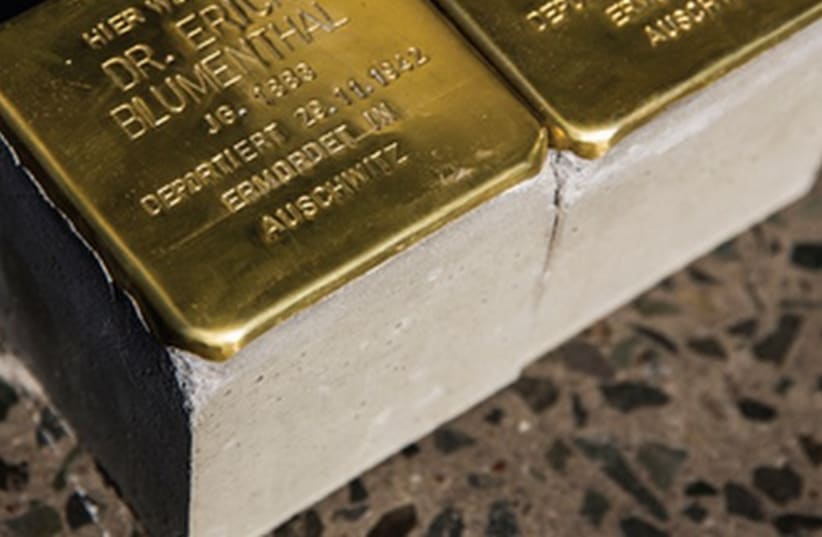During my visit I was pleased to learn that the university and the city of Lüneburg have squarely addressed the issue of Holocaust memory. Lüneburg is of course not the only European city to memorialize its former citizens through the placement of Stolpersteine (brass stumbling blocks placed in front of the homes of residents murdered in the Holocaust). However, no other town in Germany can claim that it has an angular, metallic-skinned Daniel Liebeskind-designed classroom building which evokes the disorienting experience of the Holocaust, constructed among former red-brick Wehrmacht barracks, which today serve as the campus of Leuphana University.
But to add to this dramatic setting is the fact that this campus finds itself in one of the most interesting and charming towns in Germany. Lüneburg is a medieval treasure with over 1,000 beautifully preserved buildings, grand Gothic churches and a splendid town hall, all easily accessible in a pedestrian area.
It is often said that location is everything and so it is with Lüneburg. The town’s grandeur can be traced to its good fortune of having been built on salt deposits that could be easily mined. In the Middle Ages, salt was in great demand for the pickling of Baltic and North Sea herring. Lüneburg soon became a member of the prestigious Hanseatic League of city trading partners that dominated commercial activity along the coast of Northern Europe. Producing 30,000 tons of salt annually, Lüneburg became rich and powerful and its inhabitants built magnificent gabled homes and businesses to showcase their wealth.
However, with the collapse of the Hanseatic League and the shrinking supply of herring in the mid-16th century, Lüneburg soon lost its standing as one of the wealthiest towns in Northern Germany. For the next 500 years, few buildings were built in the center of the town, permitting perhaps the unintentional preservation of Lüneburg’s cultural heritage. By the end of the 19th century, Lüneburg evolved into a garrison town until the 1990s.
A concerted effort by the town fathers to preserve the past has resulted in making Lüneburg an architectural medieval masterpiece. Located a mere 30 minutes by train from Hamburg, visitors can easily make this town of 72,000 inhabitants a day’s excursion. Strolling leisurely through the pedestrian zone, one can shop at high-end boutiques, stop at cafes or enjoy German, Greek or Italian cuisines between visits to historical sites.
But Lüneburg has a dark past. It is at the Lüneburg State Mental Hospital that between October 1941 and mid-1945, some 300 children were murdered as part of the Nazi child euthanasia program. And during the Second World War, thousands of Wehrmacht troops were garrisoned in the town’s barracks. Today, the former Scharnhorst-Kaserne, which is used by Leuphana University as classroom and academic buildings, is a stark reminder of that time.
It is also in Lüneburg that on May 23, 1945 Reichsführer-SS Heinrich Himmler committed suicide while in British custody. He is buried in an unmarked grave in a nearby forest. And just south of the town, in the Lüneburg Heath, the German Instrument of Surrender was signed in 1945. Soon thereafter, Germany’s first war crimes trial – the Belsen Trial – was held in Lüneburg, bringing to justice 45 SS men, women and kapos.
But the town has not shirked its responsibility of addressing the past. Since 1987, the Geschichtswerkstatt Lüneburg e.V. (Historical Workshop Lüneburg) has maintained a topical library in its “Lesecafe,” and sponsors walking tours with a focus on the town’s Stolpersteine. Additionally, it provides an historical perspective of Lüneburg’s former Jewish families, and the town’s role during the Nazi period, called “Lüneburg under the Swastika.”
However, most noteworthy has been the commissioning of the American architect, Daniel Liebeskind, the Polish born son of Holocaust survivors. No doubt with Liebeskind’s Holocaust-focused design of the Jewish Museum in Berlin in mind, Leuphana University and the City of Lüneburg decided that the rectangular Scharhorst-Kaserne campus buildings needed a significant counterpoint. Fittingly, the cornerstone of the building was laid to coincide with the anniversary of Europe’s liberation from National Socialism.
With the intent that the building design should pose questions and inspire dialogue, Liebeskind has presented the town with a sweeping angular metallic/glass structure, the inside of which creates a feeling of disorientation. There is a labyrinth of concrete halls, some of which are straight or crooked, along with voids that lead nowhere. His use of dark red colors is also not lost on the visitor. Liebeskind has brilliantly succeeded in producing a thought-provoking structure that challenges students to learn from Lüneburg’s rise, fall and rebirth to become one of Germany’s most architecturally significant cities.
The writer is the director of the award winning Holocaust-era documentary Refuge: Stories of the Selfhelp Home (www.refugestories.com), is a speaker on behalf of the Illinois Holocaust Museum and Education Center, and blogs at www.sightseeinginisrael.com
